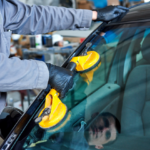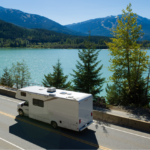As winter turns into spring and the rain starts pouring down, it’s important to be on top of the changing road conditions in your area. April Showers — in moderation — are great for May flowers, but they also mean slippery roads that can be tricky for drivers.
Wet weather accidents can impact insurance rates
Wet road conditions contribute to a significant number of accidents in the United States each year, especially during the months between winter and summer. According to the Department of Transportation, wet pavement causes more than 900,000 accidents yearly — approximately 70% of all weather-related car accidents in the U.S. More importantly, they cause nearly 4500 fatalities a year.
Like any accident, wet-weather collisions can result in damage to your vehicle and potential injuries, triggering the need to file a claim with your insurance provider — which, in turn, can directly impact your auto insurance.
Accidents you cause generally lead to a higher insurance premium, although some states won’t raise your premium for lower-cost damages. Even not-at-fault accidents can signal a potential for future accidents and can still raise your rate in certain states. While these increases may be less than for at-fault accidents, not-at-fault incidents remain on your driving record for a specified period, which varies by state, so they can affect your rates for years to come.
9 tips for safer driving on rainy roads
So, how do you drive responsibly and stay safe on those rainy spring roads? Here are our 8 tips
Know about hydroplaning
Hydroplaning occurs when a layer of water builds up between your tires and the road surface, causing a loss of traction. To minimize the risk, drive in the tire tracks left by the car in front of you, as these areas are often less affected by standing water.
Love your tires
Always maintain proper tire pressure and replace worn-out tires before they become dangerous. Consider investing in quality all-season or rain tires to provide better grip in wet conditions. Tires are safe for wet conditions as long as there is sufficient tread. To check, insert a quarter into the tire’s tread with George Washington’s head facing down. If the top of his head is visible, it indicates a worn tread, signaling the need to replace your tires.
Ensure proper visibility
Beyond simply replacing wiper blades and making sure your windshield defroster works, drivers should be proactive about visibility. Rain often leads to misty windows, so using air conditioning or cracking the windows slightly can help reduce interior fog. You might also want to consider applying a water-repellent treatment to your windshield, which can disperse water and improve visibility in heavy rain.
Reduce speed and keep your distance
It’s important to be mindful of the distance between you and the driver in front of you. Try the three-second rule. Choose a stationary object, like a signpost or a tree, and start counting when the front vehicle passes it. If you reach the object before counting to three, you’re following too closely. In wet or slippery conditions, extend the distance to four seconds or more for a safer reaction time just in case the vehicle in front slows down or suddenly stops.
Skip cruise control
Disabling cruise control during wet conditions helps you maintain better control over your vehicle. This is particularly important when driving in heavy rain or on slippery surfaces. By being present and manually managing your speed and acceleration, you reduce the risk of skidding or losing control.
Be extra alert at intersections
When approaching intersections in rainy weather, slow down well in advance to reduce the risk of sliding on wet surfaces — especially in inclines. Also, leave some extra space between you and the car in front when you’re coming up to a red light or stop sign. Wet roads mean it takes longer to stop, so having that extra room helps if the car behind you doesn’t brake in time and bumps into you. That way, you won’t get shoved into the vehicle up ahead.
Steer clear of standing water
It might seem obvious to avoid big puddles, but even seemingly small ones can pose risks. If you come across standing water, go through it slowly to prevent hydroplaning. And since you never know if a puddle is camouflaging a deep pothole beneath the surface, try to drive around it. Doing so could save you from significant damage to your car’s tires, alignment, fender, or axle.
Mind the brakes
Rather than abruptly slamming on the brakes during an emergency, try gently braking to avoid skidding. If your vehicle is equipped with anti-lock brakes (ABS), keep a steady foot on the brake pedal during sudden stops for better control. There’s also the emergency brake. While primarily for parking, a hand brake can be helpful in rainy driving conditions for emergency stops or preventing rollbacks on slick, steep hills.
Keep up on the weather
Stay informed about weather conditions by checking forecasts and consider using weather apps or GPS systems to anticipate changes before hitting the road. Review these updates before getting in the car, as looking at weather apps on the road can be unsafe. If severe weather is expected, think about delaying your trip or finding alternative routes for a safer journey.
Driving safely can pay off!
Driving in the rain — especially during April Showers — means switching up your mindset and technique. Besides the usual vehicle checks, it’s key to understand how wet roads work and that consistently practicing safe driving reduces the risk of accidents. Not only does that contribute to a clean driving record, it can potentially help you keep car insurance premiums in check for years to come.
Let us know if you’re looking for a new auto insurance policy. Guided Solutions agents will do all the legwork for you, evaluating available policies to find options tailored to your needs and budget. Let’s get started!









